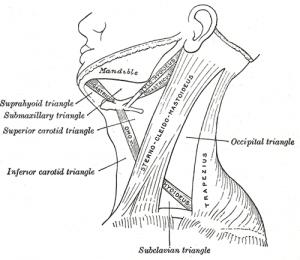Sternocleidomastoid: Difference between revisions
Venus Pagare (talk | contribs) No edit summary |
Venus Pagare (talk | contribs) No edit summary |
||
| Line 3: | Line 3: | ||
== Description<br> == | == Description<br> == | ||
Sternocleidomastoid (SCM)is a paired superficial muscle in the anterior portion of the neck. | Sternocleidomastoid (SCM)is a paired superficial muscle in the anterior portion of the neck. The sternocleidomastoid muscle (SCM) is an important landmark in the neck which divides it into an anterior and a posterior triangle. This muscle binds the skull to the sternum and clavicle.<ref name="1" /> It protects the vertical neurovascular bundle of neck, branches of cervical plexus, deep cervical lymph nodes and soft tissues of neck from damage <ref name="1">Kaur D et al. Six heads of origin of sternocleidomastoid muscle: a rare case. Internet Journal of Medical Update 2013; 8(2):62-64</ref><br> | ||
== Origin == | == Origin == | ||
It arises by two heads: | |||
*a medial rounded and tendinous sternal head (SH) | |||
*a lateral fleshy clavicular head (CH).<br> | |||
They arise from the anterolateral surface of the manubrium sterni and the medial third of the superior surface of the clavicle, respectively. The thickness of the CH is variable. The two heads are separated by a triangular surface depression, the lesser supraclavicular fossa. As they ascend, the CH spirals behind the SH and blends with its deep surface below the middle of the neck, forming a thick rounded belly. <ref name="1" /> | |||
== Insertion == | == Insertion == | ||
Lateral surface of the mastoid process through a strong tendon, and to the lateral half of superior nuchal line through an aponeurosis. | |||
<br> | <br> | ||
Revision as of 20:50, 26 January 2014
Lead Editors - Venus Pagare, Kim Jackson, Joao Costa, Admin, Daniele Barilla, WikiSysop, Joshua Samuel, Oyemi Sillo, Tarina van der Stockt, Lucinda hampton and Evan Thomas
Description
[edit | edit source]
Sternocleidomastoid (SCM)is a paired superficial muscle in the anterior portion of the neck. The sternocleidomastoid muscle (SCM) is an important landmark in the neck which divides it into an anterior and a posterior triangle. This muscle binds the skull to the sternum and clavicle.Cite error: Invalid <ref> tag; name cannot be a simple integer. Use a descriptive title It protects the vertical neurovascular bundle of neck, branches of cervical plexus, deep cervical lymph nodes and soft tissues of neck from damage Cite error: Invalid <ref> tag; name cannot be a simple integer. Use a descriptive title
Origin[edit | edit source]
It arises by two heads:
- a medial rounded and tendinous sternal head (SH)
- a lateral fleshy clavicular head (CH).
They arise from the anterolateral surface of the manubrium sterni and the medial third of the superior surface of the clavicle, respectively. The thickness of the CH is variable. The two heads are separated by a triangular surface depression, the lesser supraclavicular fossa. As they ascend, the CH spirals behind the SH and blends with its deep surface below the middle of the neck, forming a thick rounded belly. Cite error: Invalid <ref> tag; name cannot be a simple integer. Use a descriptive title
Insertion[edit | edit source]
Lateral surface of the mastoid process through a strong tendon, and to the lateral half of superior nuchal line through an aponeurosis.
Nerve Supply[edit | edit source]
Spinal accessory nerve (XI), with sensory supply from C2 & C3 (for proprioception)
Blood Supply[edit | edit source]
Sternocleidomastoid branch of the Occipital artery
Action[edit | edit source]
Draws the mastoid process down toward the same side which causes the chin to turn up toward the opposite side; acting together, the muscles of the two sides flex the neck
Function[edit | edit source]
Rotation of the head to the opposite side or obliquely rotate the head. It also flexes the neck. When acting together it flexes the neck and extends the head. When acting alone it rotates to the opposite side (contralaterally) and slightly (laterally) flexes to the same side. It also acts as an accessory muscle of inspiration.
Resources[edit | edit source]
Recent Related Research (from Pubmed)[edit | edit source]
References[edit | edit source]
References will automatically be added here, see adding references tutorial.







